12 Types of Dragonflies: The Different Species To Know
Author: Jen Worst | Editor: Omar Alonso
Review & Research: Jen Worst & Chris Miller
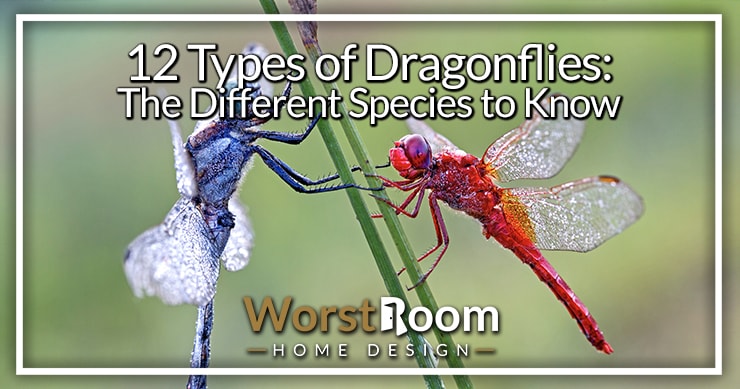
The different types of dragonflies are some of the most attractive varieties of insects in existence. Even among the dragonfly species there's such a vast diversity of beauty.
While the larger group of insects can have flightless creepy crawlies or even flies and mosquitoes that can make life quite difficult, dragonflies are distinct looking fliers that are fascinating to the eye.
There are approximately 5,000 species of dragonflies that are known to human beings and discoveries within the practice of taxonomy still continues.
Dragonflies, along with damselflies, make up the Odonata order of flying insects. These skilled fliers also catch prey mid-flight. The following is a list of the 12 most common and spectacular types of dragonflies and plus a couple of damselflies for good measure that you may run into.
Types of Dragonflies
While there is a countless variety of dragonfly out there, most of them are imperceptibly different from these main groupings. These are the ones you want to be able to identify. You'd enjoy reading about the dragonfly life cycle as well (it's surprising how short their lives are).
Clubtail Dragonfly
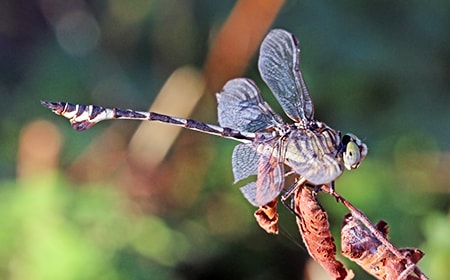
Clubtail dragonflies belong to the family of Gomphidae and are commonly found around water bodies in North America. There are approximately 100 species of clubtail dragonflies.
While all the members of this species have unique characteristics, the one thing most of them have in common is the club-shaped tail. Sometimes they're called bladetail dragonflies.
Having said that, this club-like quality at the end of the abdomen is more pronounced in the male species than in the female and may even be entirely absent in some species.
There are about 14 genera that come under the general category of clubtail dragonflies.
River Cruiser Dragonfly
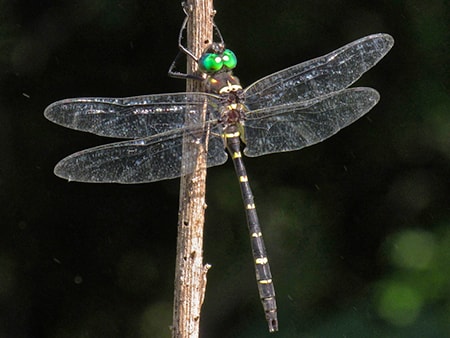
River cruisers, as the name suggests, derive their name from their distinct trait of cruising long distances, often along river banks and roads.
While they are commonly called cruisers, the name for the family these cruisers belong to is Macromiidae.
These are large types of dragonflies that typically have a long and slender body with distinct yellow stripes. But the one trait that sets river cruisers apart from other species is their bright green eyes. These species are commonly found in North America.
Skimmer Dragonfly
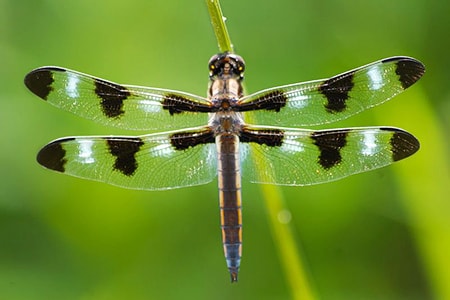
Skimmers are commonly found in North America and are an umbrella category that have approximately 105 species that belong to the Libellulidae family of dragonflies.
The Libellulidae family is the largest dragonfly family in North America, among which skimmers occupy a large chunk of the population.
Another name for skimmers is perchers. They are so called because they like to perch on crops and vegetation that are exposed to sunlight.
There are at least 26 different genera under the larger subgroup of skimmers, which can often make it difficult to categorize them.
Spiketail Dragonfly
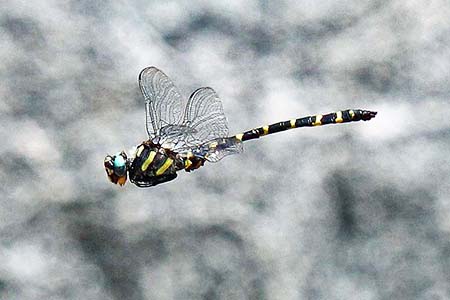
Spiketails is the common name for dragonflies that belong to the Cordulegastridae family. With only eight or nine species in the single genus, spiketails are one of the least populous in the family of dragonflies, at least in the United States.
These dragonflies have long bodies and are typically large in size. They have a brown or black abdomen that has a distinct bright yellow pattern.
These are active dragonflies that are usually seen flying about, rarely ever perching like the skimmers. Many of these spiketail dragonflies can be found in wooded areas near the Rocky Mountains.
Emerald Dragonfly
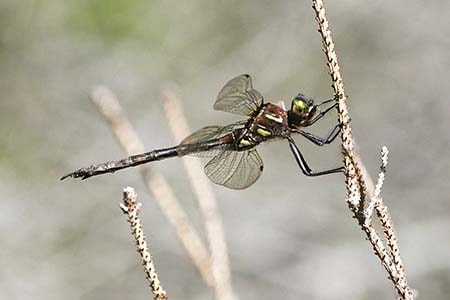
Emerald dragonflies or simply emeralds belong to the Corduliidae family. They derive their common name from their striking emerald green eyes and are commonly found in most regions of the United States.
Having said that, there are different species of the emerald dragonfly that may be found in different parts of the country.
While the practice of taxonomy among dragonflies is an ongoing one, so far fifty at least native Corduliidae species have been identified, divided into six different genera.
Of these, the American emerald is the sole species that is native to North America. These dragonflies are usually found in lakes and near forested areas.
They can also be found flying from early spring into the latter half of the summer, depending on the region.
Petaltail Dragonfly
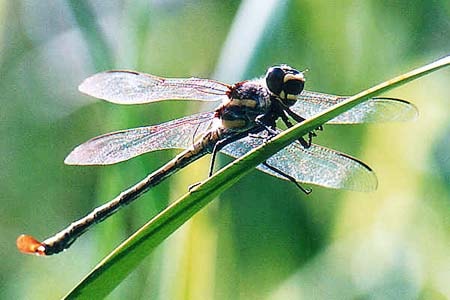
Petaltail dragonflies, again, get their name from the shape of their tails which are long and straight like petals.
These dragonflies belong to the Petaluridae family, which is said to be the oldest among the dragonfly families (approximately 150 million years).
There are 11 documented species of this family recorded in the world, the largest of which is found in Australia.
The curious thing about petaltails is that they can be found around fens when they are growing up, as opposed to most other dragonfly types that are found in water habitats. Perhaps as a result of this, these dragonflies take longer than most to mature into adults.
Hawker Dragonfly
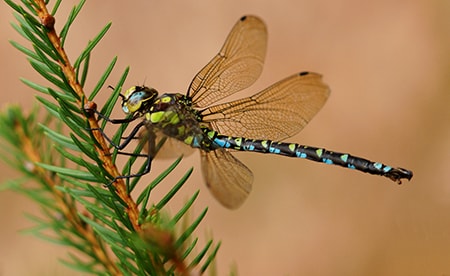
Hawker is a common name for the types of dragonflies belonging to the family Aeshnidae. The genera in this family are also said to be the fastest flying dragonflies.
These dragonflies can commonly be found in North America and are believed to be the largest dragonfly types in the world.
There are several interesting things about hawkers, including but not limited to the fact that they mate mid-flight and then lay eggs somewhere nearby, preferably in the water.
There is also evidence that suggests female hawkers can fake death to avoid the advances of a male they don't consider suitable for mating.
Tigertail Dragonfly
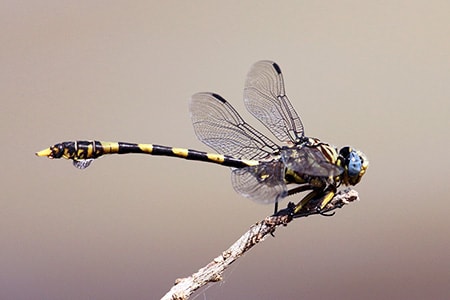
Tigertails is the common name for dragonflies that belong to the Sythemistidae family. The family has about 43 species, of which tigertails are a prominent variety.
Tigertails look quite similar to species in the corduliidae and gomphidae families of dragonflies. These are small dragonflies with a slender abdomen.
Tigertails are one of the oldest species of dragonflies and are most commonly found in Australia and New Guinea.
They like to be around lakes, small streams, ponds or any other water body with slow-moving water. They get their name from the combination of yellow and black stripes on their tail.
Saddlebag Dragonfly
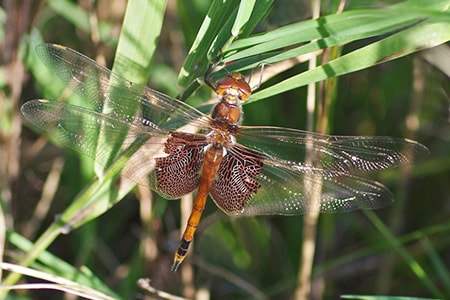
Saddlebags are a species of dragonflies that are commonly found in Canada, the United States, and the south of Mexico.
These dragonflies also belong to the Libellulidae family. Also known as black saddlebags, these dragonflies like to be around slow-moving water bodies that don’t have fish and especially around a lot of vegetation.
This species of dragonflies are known to migrate, frequenting the North in the spring and moving towards the Atlantic coast in the fall.
An interesting thing to note about saddlebags is that they are also known as dancing gliders because they cupulate and lay eggs through a mating dance. They are especially useful to control a growing mosquito population.
Darner Dragonfly
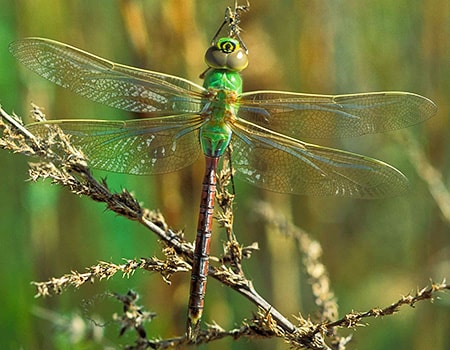
Like hawkers, darners also belong to the Aeshnidae family. They have a striking black body with distinct blue spots.
They can commonly be found in the United States, typically around water bodies like lakes, ponds and streams.
There are several varieties of darners and though they have several different features, they share several things in common which categorizes them into the same family.
While most males in the species have bright blue dots on their abdomen or thorax, the females have spots in hues of yellow or green.
Unlike most other species of dragonflies, darners do not have thoracic stripes on the top or the bottom, which is another unique identification that sets them apart.
Spreadwing Damselfly
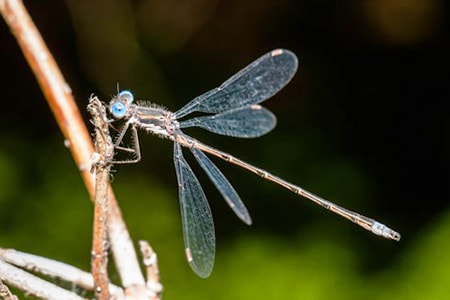
While damselflies are not exactly the same as dragonflies, both fall in the same scientific category of Odonata which denotes flying insects.
Spreadwing damselflies acquire their name because they keep their wings spread even when they are resting, which is usually not the case for damselflies.
In North America alone, there are 20 species of spreadwing damselfly species. Spreadwing damselflies, like many other damselflies in their family, like to be around still or slow-moving water bodies.
They tend to perch on crops and vegetation in search of food, often. This is also the best time to catch sight of them as they make themselves visible in the sunlight.
Broadwing Damselfly
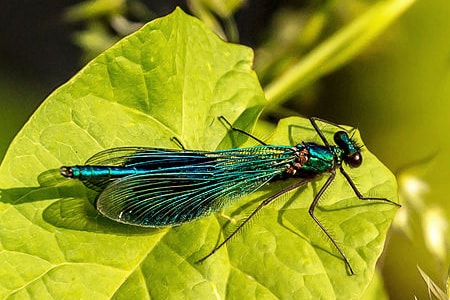
Broadwing damselflies belong to the family of Calopterygidae. The two species belonging to the North American genera are also known for their large sizes and bright colors.
River jewelwing is one of the most prominent species in the broadwing damselflies family, because of its distinctly wide wings.
These are large damselflies, typically the largest in any region. They have bright and flashy covers, often with hints of metallic green or blue.
They also have large, spotted wings that give them their distinct look. While dragonflies tend to be larger than damselflies, the River Jewelwing can be just as large as a dragonfly.
The Different Types of Dragonflies are Fly!
Dragonflies, as the various types described above show, are some of the most fascinating creatures not only to look at but also because of their unique characteristics.
Even the stories behind how their names are derived are interesting because they reveal something about their physical characteristics or habits.
While insects often get a bad name because of their common association with mosquitoes or house flies, dragonflies are an interesting species of insects that do not seem to irritate humans by buzzing around them.
On the contrary, all the types of dragonflies will find curious humans trying to get a look at them intrusive or troubling. Oh, how the tables turn!
You'll Also Enjoy:
- 10 Plants That Repel Mosquitos in Your Yard & Indoors
- 7 Plants That Repel Fleas & Provide Secondary Benefits You'll Love
- 6 Poisonous Flowers That People Grow for Some Ridiculous Reason
- 6 Plants That Repel Ants Outdoors & Inside Your Home
- 21 Plants That Repel Ticks: Fresh Smells We Love & Ticks Hate!



